Related Research Articles

Maidstone is the largest town in Kent, England, of which it is the county town. Maidstone is historically important and lies 32 miles (51 km) east-south-east of London. The River Medway runs through the centre of the town, linking it with Rochester and the Thames Estuary. Historically, the river carried much of the town's trade as the centre of the agricultural county of Kent, which is known as the Garden of England. There is evidence of settlement in the area dating back before the Stone Age. The town, part of the borough of Maidstone, had an approximate population of 100,000 in 2019. Since World War II, the town's economy has shifted from heavy industry towards light industry and services.
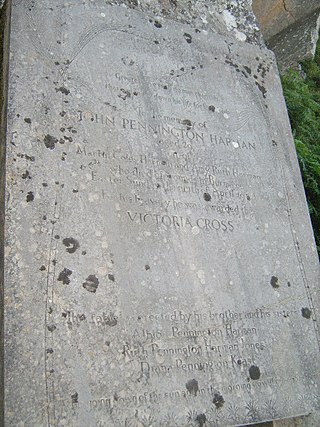
Lance Corporal John Pennington Harman VC was a British Army soldier and an English recipient of the Victoria Cross (VC), the highest and most prestigious award for gallantry in the face of the enemy that can be awarded to British and Commonwealth forces.

John Coleman VC was an English recipient of the Victoria Cross, the highest and most prestigious award for gallantry in the face of the enemy that can be awarded to British and Commonwealth forces. He was a native of Norwich.

Charles Henry Lumley VC was a Scottish recipient of the Victoria Cross, the highest and most prestigious award for gallantry in the face of the enemy that can be awarded to British and Commonwealth forces.
Sergeant Thomas James Harris VC MM was a British Army soldier and an English recipient of the Victoria Cross (VC), the highest and most prestigious award for gallantry in the face of the enemy that can be awarded to British and Commonwealth forces.
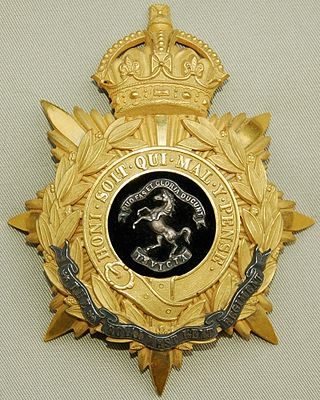
The Queen's Own Royal West Kent Regiment was a line infantry regiment of the British Army based in the county of Kent in existence from 1881 to 1961. The regiment was created on 1 July 1881 as part of the Childers Reforms, originally as the Queen's Own (Royal West Kent Regiment), by the amalgamation of the 50th (Queen's Own) Regiment of Foot and the 97th (The Earl of Ulster's) Regiment of Foot. In January 1921, the regiment was renamed the Royal West Kent Regiment (Queen's Own) and, in April of the same year, was again renamed, this time as the Queen's Own Royal West Kent Regiment.

Maidstone East is one of three railway stations in the town of Maidstone, in Kent, England, but currently the only one with a regular all-day direct service to London. The station is on the Maidstone line, 39 miles 76 chains (64.3 km) from London Victoria, and is served by trains operated by Southeastern.

Maidstone Museum is a local authority-run museum located in Maidstone, Kent, England, featuring internationally important collections including fine art, natural history, and human history. The museum is one of three operated by Maidstone Borough Council. The building is Grade II* listed.
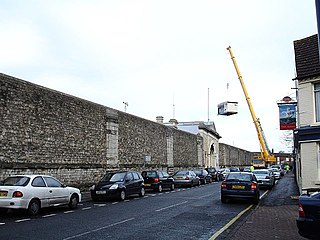
HM Prison Maidstone is a Category C men's prison, located in Maidstone, Kent, England and operated by His Majesty's Prison Service.
The 97th Regiment of Foot was an infantry regiment of the British Army, formed in 1824 and amalgamated into the Queen's Own in 1881.
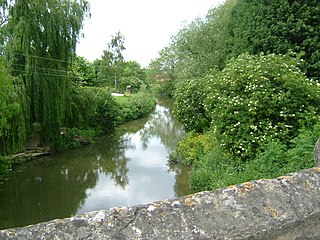
The River Beult is a tributary of the River Medway in South East England.
In countries whose armies are organised on a regimental basis, such as the army of the United Kingdom, a regimental museum is a military museum dedicated to the history of a specific army regiment.

The Queen's Own West Kent Yeomanry was a British Army regiment formed in 1794. It served in the Second Boer War and the First World War. It amalgamated with the Royal East Kent Yeomanry to form the Kent Yeomanry in 1920.
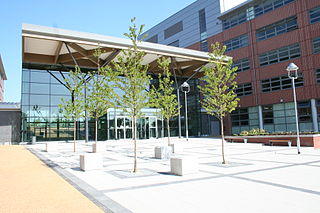
MidKent College is a further education college in Kent, England. It runs courses from two separate campuses in Maidstone and Medway, including a number of higher education courses.

The regimental depot of a regiment is its home base for recruiting and training. It is also where soldiers and officers awaiting discharge or postings are based and where injured soldiers return to full fitness after discharge from hospital before returning to full duty. Normally, a variety of regimental stores will also be kept at the depot. The regimental depot is not the same as the regimental headquarters, though in practice the two will often be co-located.

Invicta Park Barracks is a military installation in Maidstone, Kent. It is set to close in 2029.

The Kent Yeomanry was an artillery regiment of the Territorial Army (TA) formed in 1920 by the amalgamation of the Royal East Kent Yeomanry and West Kent Yeomanry. For the Second World War it was expanded to form two field artillery regiments – 97 Field Regiment, Royal Artillery and 143 Field Regiment, Royal Artillery – which saw active service in North Africa, Italy and North-West Europe, both with the BEF in 1940 and on the Second Front in 1944–45. Post war it was reconstituted as 297 Light Anti-Aircraft Regiment, Royal Artillery before being amalgamated in 1961 with the 3rd/4th County of London Yeomanry (Sharpshooters) to form the Kent and Sharpshooters Yeomanry.
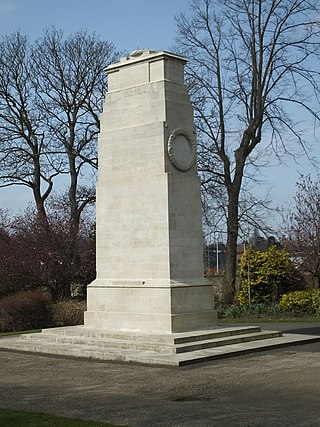
The Queen's Own Royal West Kent Regiment Cenotaph is a First World War memorial dedicated to members of the Queen's Own Royal West Kent Regiment and located in Maidstone in Kent, south-eastern England. Unveiled in 1921, the memorial was designed by Sir Edwin Lutyens following his design for the Cenotaph on Whitehall in London and is today a grade II* listed building.
The Royal Berkshire Regiment War Memorial or Royal Berkshire Regiment Cenotaph is a First World War memorial dedicated to members of the Royal Berkshire Regiment and located in Brock Barracks in Reading, Berkshire, in south-east England. Unveiled in 1921, the memorial was designed by Sir Edwin Lutyens, based on his design for the Cenotaph on Whitehall in London, and is today a grade II* listed building.

The Memorial to the Home of Aviation is a stone memorial sculpture at Eastchurch, on the Isle of Sheppey in the English county of Kent. The Grade II* listed memorial, unveiled in 1955, commemorates the early aviation flights from Leysdown and Eastchurch by members of the club that became the Royal Aero Club of Great Britain in 1910, and the air base established by the Royal Navy near Eastchurch in 1911.
References
- ↑ "Queen's Own Royal West Kent Regiment Museum". Maidstine Museum. Retrieved 5 June 2018.